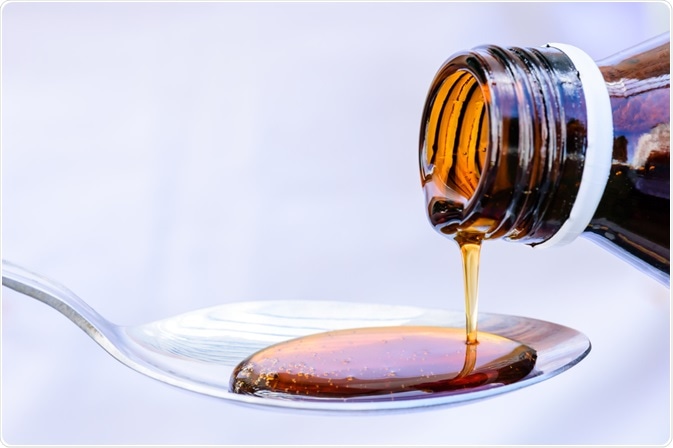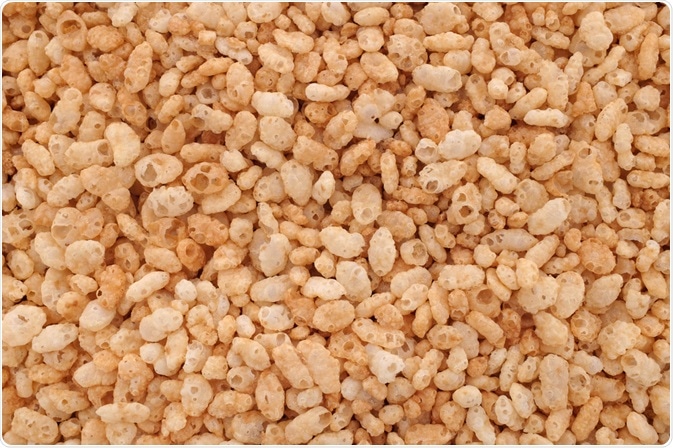Hot melt extrusion is a manufacturing technique that was originally established in the early 1930s for use in the plastics and food industries but is now gaining popularity in the pharmaceutical industry as well.
Around half of all plastics products are made using hot-melt extrusion, which is the process of producing a new material (i.e. an extrudate) by forcing a melted polymer through an orifice, as heat and pressure are applied.
 Image Credit: siam.pukkato/Shutterstock.com
Image Credit: siam.pukkato/Shutterstock.com
As mentioned, hot-melt extrusion was developed to create polymer products of different shapes and densities that can be used to form a range of plastic products – including bags, foams, films, sheets, and pipes.
Since its industrial application back in the 1930s, hot-melt extrusion has gained increasing attention from the pharmaceutical industry and academia, since it enables the continuous manufacturing of various dosage formulations.
Recently, the technology has been applied in the pharmaceutical industry to create new medical devices and drugs. The process can be used to produce substances for the creation of therapeutic drug-eluting devices or to combine active pharmaceutical ingredients (APIs) with polymers, which enhances the bioavailability of APIs and can also mask their bitter taste.
Another advantage is the ability to incorporate analytical technology for a quality-by-design approach for continuous manufacturing; in turn, hot-melt extrusion has been classified as meeting the U.S. Food and Drug Administration (FDA) goals for the design, analysis, and quality control of the active extrusion process.
The process of hot melt extrusion
The hot-melt extrusion process is carried out using an extruder, which is a barrel with a platform supporting one or two rotating screws that push substances down the barrel. An extruder is made up of four main components, as follows:
- an opening that is used to introduce substances to the barrel; it may have a container that the substances to be extruded are put into, or it may be continuously supplied with the substances by one or more external units
- a process platform made up of the barrel and screw(s) that move and, where required, mix the substance
- an orifice that shapes the substance as it exits the extruder
- additional apparatus where the product is cooled, cut, and/or collected
There are two types of extruders: a single-screw extruder and a twin-screw extruder.
Single-screw extruders
These contain just one rotating screw within a stationary barrel that is divided into a feeding zone, a compression zone, and a metering zone. Single-screw extruders (SSEs) are predominantly used to melt and process polymers into continuous shapes.
Twin-screw extruders
These are more advanced devices containing twin-screw systems with co-rotating or counter-rotating screws. Twin-screw extruders (TSEs) are used to melt polymers and mix them with other substances such as APIs and pigments. They are also used to remove volatile material.
The extrusion screw is generally characterized by its length-to-diameter ratio, which is usually around 20−40:1. The extruders typically used in pre-commercial plants are around 18 to 30 mm in diameter, whereas those used for production have much greater diameters that often exceed 50 mm.
Advantages of a twin-screw extruder
Twin-screw extruders offer several advantages over the single-screw extruders in industrial applications Advantages include easier material feeding, less tendency to overheat, higher process flexibility, and superior control of operating parameters.
Some of the advantages of using a twin-screw extruder over a single-screw extruder include the following:
Increased versatility
The use of two screws mounted in parallel enables different configurations and varying conditions in the different extruder zones. Various types of twin-screw extruders are, therefore, available with different operating mechanisms that can be employed for different applications.
Lower tendency to overheat
In the single-screw extruder, increasing the speed of the screws produces heat, which can degrade drugs that are sensitive to an elevated temperature. With twin-screw extruders, heat is controlled by external sources and produced independently of screw speed. The tendency to overheat is much lower, which represents an important advantage for heat-sensitive drugs and for decreasing residence time.
Decreased residence time
The length of time for which a substance stays in the extruder is reduced, primarily due to a relatively fast-melting time when compared to that of the single-screw extruder. A typical extrusion process only lasts between five and ten minutes.
Self-cleaning
In a twin-screw extruder with intermeshing co-rotating screws, the flight of one of the screws wipes the base of the parallel screw which ensures full emptying of the device and reduces the amount of product that is wasted at the end of a batch.
Increased flexibility
Process parameters can be easily and continuously controlled, depending on the desired extrusion rate or mixing function. The die plates are also easily changed if a different extrudate diameter is desired, which means a wide variety of formulations can be processed with the use of a single device.
Improved mixing
The intermeshing co-rotating screws in the twin-screw extruder enable better mixing. Either of two types of mixing can be achieved: distributive mixing or dispersive mixing. The first type enables the even blending and limited degradation of substances, which is useful for processing APIs that are sensitive to heat or shearing. Conversely, in dispersive mixing processes, the solid domain is broken down into a finer state, which aids the compounding of two or more APIs.
Hot-melt extrusion in the pharmaceutical industry
What is Melt Extrusion and How Does it Help Us Make New Medicines?
Hot-melt extrusion technology has gained considerable popularity in the pharmaceutical industry due to the advantages it offers over traditional manufacturing techniques and provides an efficient production process that enhances the quality of products. In drug development, the main use of the method is the molecular dispersion of active pharmaceutical ingredients (APIs) into polymer matrices to form solid solutions.
Consequently, hot-melt extrusion has been used for a range of applications, which includes enhancing the bioavailability of water-insoluble drugs by producing a solid solution, controlling drug release, masking the taste of bitter APIs, as well as creating thin films.
The bioavailability of APIs depends on their solubility in water, and making water-insoluble (or poorly soluble) drugs more soluble presents a significant challenge in drug development. The use of high-throughput techniques in pharmaceutical screening has revealed that many of the compounds are highly lipophilic and poorly soluble.
The methods currently utilized in drug discovery generate large molecules with high lipophilicity, which means they are poorly soluble and non-permeable. Fewer than 10% of candidate drugs produced are highly soluble and permeable, and up to 40% of drugs on the World Health Organization's (WHO’s) drug list have poor solubility and lipophilicity.
Researchers have made significant efforts to improve dissolution rates and solve solubility problems. hot melt extrusion has been a highly successful application for dispersing APIs into hydrophilic polymer matrices at the molecular level to form solid solutions that enable the delivery of poorly soluble compounds or to create films such as transdermal patches.
Hot-melt extrusion in the food industry
In the food industry, hot-melt extrusion is a food processing technology that involves mixing, cooking, kneading, and shaping mixed ingredients as they are forced through an opening called a die that has been specifically designed for food items. The high-temperature process results in reduced contamination with microorganisms and inactivated enzymes.
 Image Credit: Sarah Marchant/Shutterstock.com
Image Credit: Sarah Marchant/Shutterstock.com
The operation involves ingredients being supplied to the extruder barrel which is then conveyed by the screw(s). Further along the barrel, the presence of smaller flights restrict volume and cause the food to be more resistant to movement.
The aforementioned process results in the barrel becoming full and the area between the flights becoming compressed. Subsequently, as the food moves along the barrel, the screw kneads it into a half-solid mass. Additional heating can then be used to quickly increase the temperature.
The food then moves along to an area of the barrel where the flights are smallest and pressure is further increased as the food is pushed through one or more dies at the barrel’s end. As the food emerges from the discharge end, it expands to adopt the final shape and then cools as any moisture forms steam.
Using the technique, various different shapes (including doughnuts, shells, rods, or tubes) can be generated. Typical examples of the foods produced using extrusion include puffed, crunchy or crispy cereals, as well as starchy “finger” foods.
Hot-melt extrusion disadvantages and challenges
There are a few disadvantages to using hot-melt extrusion. The energy input requires is higher than it is with other methods and certain thermolabile substances might not be suited to the high temperatures that are used during the process.
Although the dosage forms produced are often highly stable in the long-term, recrystallization of APIs as a result of storage has been reported. The stability depends on the type of API, its physical state in the final form, the polymers and excipients, but also how the extrudate is stored and packed.
Over the past two decades, extruders have been modified to meet the particular requirements of the pharmaceutical industry, since certain regulatory standards must be met if good manufacturing practices are to be upheld. Contact parts within the extruder must not be reactive with the compounds and equipment needs to meet cleaning and validation criteria.
The FDA has permitted continuous processing providing that it fulfills the quality-by-design principle. This means that the generation of high-quality products must involve extensive control of raw materials and process parameters so that the quality of the final product can be accurately predicted. This, in turn, reduces overall production costs, since continuous manufacturing involves the more effective use of the equipment and lowers the requirement for the analysis of final products.
Process analytical technology (PAT) has become increasingly popular in the pharmaceutical industry and is already applied at the laboratory scale for hot melt extrusion to track, analyze and characterize the process and the resulting products. Several elements of in-process monitoring can be determined immediately downstream of the extruder to ensure the quality of products is assessed in real-time.
Analytical techniques, including near-infrared spectroscopy and Raman spectroscopy, are also included in the monitoring system. PAT enables researchers to improve the design, analysis, and quality control of the continuous manufacturing process.
Sources
- Lovett, D. Hot melt extrusion technology for continuous manufacturing. European Pharmaceutical Review, 2018. Available at: europeanpharmaceuticalreview.com.
- Dourdoumis, D et al. A Review of Hot-Melt Extrusion: Process Technology to Pharmaceutical Products, ISRN Pharmaceutics 2012, Article ID 436763. Available at: doi.org/10.5402/2012/436763.
- Bordoloi, R and Ganguly, S. Extrusion technique in food processing and a review on its various technological parameters. Ind. J. Sci. Res. and Tech. 2014; 2(1):1-3.
- Patel, G et al. A Review of Hot Melt Extrusion Technique. International Journal of Innovative Research in Science, Engineering and Technology 2013; 2(6): June 2013:2194-2198.
- Hot Melt Extrusion. Thermofisher Scientific. Available at: thermofisher.com.
- Repka, M et al. Hot-Melt Extrusion: from Theory to Application in Pharmaceutical Formulation. AAPS PharmSciTech. 2016; 17(1):20–42. Available at: doi: 10.1208/s12249-015-0360-7.
- Jones, D et al. Hot-melt extrusion: an emerging drug delivery technology. Pharmaceutical Technology Europe 2009; 21(1) Available at: www.pharmtech.com/hot-melt-extrusion-emerging-drug-delivery-technology.
Further Reading